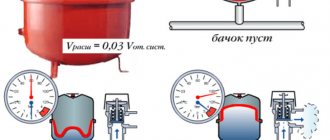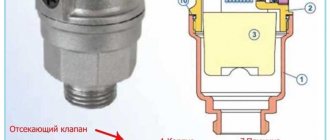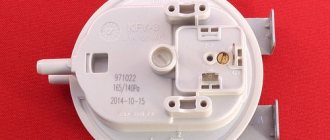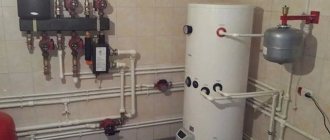Many of those who received receipts for services this year were very surprised at how impressive the amounts for heating turned out to be. Of course, when you designed the heating of an apartment and installed heating in a gas-type apartment, it was understood that the main costs would be only the installation of the system. Not long ago, new rules were established that explain the calculation of heating in an apartment. In addition, another additional line appeared in the receipt - ONE heating.
Apartment heating calculation
In this article we will help you determine how heating in an apartment is calculated. According to the new rules and standards of calculation, payment for any utility service, including heat energy, will be divided into several parts: payment for services provided in the residential premises, and payment for services provided for the general needs of the entire house. For this reason, the heating receipt will now have not only one line, but two.
Changes in 2019 that affected heating
When calculating heating payments in apartment buildings, some parameters have changed:
- There were two heating options, it was divided into 2 categories: individual and communal.
- We have developed special formulas for calculating those square meters and rooms that are not heated, and for residential areas with autonomous heating.
- Individual calculation of heating payments has appeared in multi-apartment buildings, which are only partially equipped with heat meters.
Also, for a more detailed calculation, new indicators were introduced that affect the amount of payment. Such as the area of common areas and the amount of Gcal of heat consumed. This value is the sum of the indicators that were taken from individual heat metering equipment or installed on the heating systems of the owners of radiator distributors.
Methodology for calculating thermal energy for heating
The procedure for calculating heating in a residential building depends on the availability of metering devices and on the way in which the house is equipped with them. There are several options for equipping multi-apartment residential buildings with meters, and according to which thermal energy is calculated:
- the presence of a common building meter, while apartments and non-residential premises are not equipped with metering devices.
- Heating costs are controlled by a common house meter, and all or some rooms are equipped with metering devices.
- There is no general device for recording the consumption and consumption of thermal energy.
Before calculating the number of gigacalories spent, it is necessary to find out the presence or absence of controllers in the house and in each individual room, including non-residential ones. Let's consider all three options for calculating thermal energy, for each of which a specific formula has been developed (posted on the website of state authorized bodies).
How to calculate the amount yourself
You can calculate the amount of payment for heating in your apartment yourself. But before that, consider some factors:
- Determine how many months a year the payment for heat occurs. Only for the period when hot water is supplied to the batteries or throughout the calendar year.
- Find out if your apartment building has a communal heat meter installed.
- Find out whether your living space is equipped with a separate heat meter or its own radiator distributors.
- Determine how the heating system in your living space is filled with hot water. Via the central city system or through special equipment installed in your home.
Based on these parameters, you can use certain formulas to calculate payments for heating an apartment.
Important Calculations
How is heating in an apartment calculated? The corresponding government decree approves the procedure for payments and submission of documents. There is a certain procedure for providing utility services to owners of apartments and residential buildings. Another resolution approved the rules for providing similar services to all citizens of the Russian Federation.
When faced with the question of how to calculate the heating fee, you must be guided by the rules adopted initially and in a later version. Although only the latest version for 2011 should be used, the period associated with the transition to it continues. Local government authorities at the regional level determine the list of required documents that must be followed.
How to calculate payment for heating according to the rules established by Resolution No. 354? The provided procedure determines the collection of payments not for the entire year, but only for the heating period. If the subject’s place of residence is the Moscow region, and charges for heat are made only during the period from October to May, then you can safely be guided by the information provided. If the number of months is different, you must follow the rules established by Resolution No. 307.
Payments only during heating seasons makes the calculation process much simpler and more convenient. This is a significant achievement and a plus for residents. In practice, it becomes clear that the heating fee established at a later period for residential premises is slightly higher than the amount accepted earlier. This is due to the fact that payments were divided over all 12 months. In most cases this leads to inconvenience.
How is the payment for heat in apartments calculated? The calculation algorithm is influenced by a number of factors. Among them are:
- the presence of one meter in residential premises (apartment buildings);
- the presence of heat meters in every apartment and non-residential premises;
- the presence of distributors (they should be in half of the non-residential and residential premises of an apartment building).
What are the rules for calculating payments for heat?
Be guided by the parameters that you have defined for your home and use the ready-made formula to calculate by category:
- When there is no common house heat meter (DHMU), and payments for heat supply are charged only during the months of the heating season.
- If there is no general income tax, and payments are extended over the entire calendar year.
- The house is connected to an ODPU, but separate meters are not installed in any of the premises of the building.
- The building has an ODPU installed, the apartments are partially equipped with separate devices for calculating heat energy.
If your apartment is located in a building in which ODPU are not connected, and the payment is assigned only during the heating period, the heat energy is calculated according to the standards. This is a fixed amount of energy that is required to heat 1 square meter. meters for 30 days. Standards vary depending on the region; they are adopted and approved by local leadership, taking into account climatic conditions. In this case, you can use the following formula:
P = Plz x Np x Tt
Plzh - housing area. NP - consumption standard. Тт —heat tariff.
For buildings without DPPU, in which payments are spread over 12 months, the calculation includes the coefficient of frequency of payment for utilities for heat energy. The coefficient is equal to the number of payments for the heating season divided by 12 months. And the calculation will be made according to the following formula:
P = Pl x Np x Kf x Tt
Where Kf is the calculated coefficient for monthly accounting.
What is Gcal
We should start with a related definition. A calorie refers to the specific amount of energy required to heat one gram of water to one degree Celsius (at atmospheric pressure, of course). And due to the fact that from the point of view of heating costs, say, at home, one calorie is a tiny amount, gigacalories (or Gcal for short), corresponding to one billion calories, are used for calculations in most cases. We've decided on this, let's move on.
The use of this value is regulated by the relevant document of the Ministry of Fuel and Energy, published back in 1995.
Note! On average, the consumption standard in Russia per square meter is 0.0342 Gcal per month. Of course, this figure may vary for different regions, since everything depends on climatic conditions
So, what is a gigacalorie if we “transform” it into values that are more familiar to us? See for yourself.
1. One gigacalorie is equal to approximately 1,162.2 kilowatt-hours.
2. One gigacalorie of energy is enough to heat a thousand tons of water to +1°C.
Additional calculation formulas
Meters for calculating heat energy in an apartment building are installed upstream of the building. The device shows how much heat is supplied to the apartments of the entire building. Heat is calculated proportionally for all apartments. The calculation is carried out as follows:
P = (Rebt + (Plzh x (Ot - ∑Rebt)) / Plob) x Tt
Plzh is the area of the apartment. Floor area - the total area of residential and non-residential premises in a building. From - the volume of heat energy according to the ODPU readings when paid during the heating period or according to the average heat energy indicator by month for the previous year. Tt is the tariff set for heat energy. Total - the volume of heat that is needed to heat the entire living space. ∑Tot is the volume of all heat energy consumed in residential and non-residential premises of a high-rise building.
To calculate the Obt indicator, you also need a formula:
Obt = Plz x (From / (Plob - Plind + Ploi))
Ploi - the area of those premises that are for common use. Plind is the area of residential and non-residential rooms in which there are no heating devices or their own heaters are installed.
The calculation is carried out according to the following formula:
∑Obt: From/ (Plob + Ploi) x Plob
If in one residential building an individual metering device (IMU) is installed in at least one of the apartments, it is included in the calculation of the total payment for heating. To calculate payments in houses where IPU is installed in several apartments, the same formula is used as for houses with ODPU, but without IPU.
For those premises in which there is no IPU, the Obt indicator is calculated as follows:
Obt = Plzh x (∑ObtIPU / ∑PlzhIPU)
∑ObtIPU - the total amount according to the indications of the IPU, if the calculation and accrual of payment occurs during the heating season. Or by the average monthly heat volume for the previous year. ∑PlzhIPU - area of all rooms with IPU.
It’s not easy to count the first time, but even the second time, it becomes clear what indicator and what meter readings should be inserted where
Other methods for calculating Gcal for heating
You can calculate the amount of heat that enters the heating system in other ways. For example, the formula for calculating Gcal can have two other forms:
- Q = ((V1 * (T1 - T2)) + (V1 - V2) * (T2 - T)) / 1000.
- Q = ((V2 * (T1 - T2)) + (V1 - V2) * (T1 - T)) / 1000.
All values in these formulas are the same as in the previous formula. Based on the above calculations, we can conclude that you can calculate Gcal for heating yourself. But you should seek advice from special companies that are responsible for supplying heat to the house, since their work and calculation system may differ from these formulas and consist of a different set of measures.
Many residents have difficulty converting kilocalories to kilowatts. This is due to many manuals of measuring units in the international system, which is called “C”. When converting kilocalories to kilowatts, the coefficient 850 should be used. That is, 1 kW equals 850 kcal. This calculation is much simpler than others, since it is not difficult to find out the required volume of gigacalories. 1 gigacalorie = 1 million calories.
During the calculation, it should be remembered that any modern devices have a small error. Mostly they are acceptable. But you need to calculate the error yourself. For example, this can be done using the following formula: R = (V1 - V2) / (V1+V2) * 100, where:
- R – error of a common house heating device.
- V1 and V2 are the previously indicated water flow parameters in the system.
- 100 is the coefficient that is responsible for converting the resulting value into a percentage. In accordance with operational standards, the maximum error that can be is 2%. Basically, this figure does not exceed 1%.
What temperature should be maintained in apartments?
Heating standards in apartment buildings during the cold season:
| Room type | Optimal temperature in degrees Celsius | Permissible temperature in degrees Celsius |
| Living room | 20-22 | 18-24 |
| Living room in regions with an outside temperature of -31°C or lower | 21-23 | 20-24 |
| Kitchen | 19-21 | 18-26 |
| Corridor between apartments | 18-20 | 16-22 |
| Toilet | 19-21 | 18-26 |
| Bathroom | 24-26 | 18-26 |
| Lobby, landing | 16-18 | 14-20 |
| Pantry | 16-18 | 12-22 |
In the warm season, the norm for living rooms is optimally 22-25°C, and acceptable - 20-28°C.
If the temperature in your apartment during the heating season does not meet the established standards, you can contact the service company or utility service. They are required to investigate and obtain evidence. In this case, heating payments will be reduced. But such a solution can be called a half-measure, and it will suit few people, because the apartment will still remain uncomfortable living conditions.
How to pay for heating through Sberbank online
The easiest way to pay utility bills, including heating services, is through Sberbank Online - for this, the service provides several options, which allows consumers to choose the best method for them.
The most common method is to make a payment through your personal account - to do this you need to log in and, using informative prompts, make a payment. As a rule, when creating a personal account, all details are filled out and saved, which greatly simplifies the task for the payer of services, since there is no need to enter personal account details, TIN or other information each time. Just find the supplier’s tab and click on it, and then the system will do everything itself, even generate a receipt, which, if necessary, can be easily printed. If the accounts are linked to the Sberbank Online system, there is no need to even enter data, they will already be displayed, all that remains is to confirm the action.
Also, in order not to manually enter data and details, you can use a QR code or barcode - for this you need to scan them.
The procedure in this case is quite simple and looks like this:
- first you need to go to the banking application or personal account;
- then click on the “Payments” icon (as an option – “Payments and transfers”);
- after that, select the “My Operations” section;
- then, in the window that opens, enter the data, including scanning it from the receipt;
- make the payment and complete the transaction.
In the event that it is impossible to scan the code, in order to pay you need to enter the recipient’s data using one of the following types of details:
- checking account;
- Name;
- TIN.
If the organization is not displayed in this way, then you can pay for heat supply services by entering all the recipient’s details that are indicated in the receipt.
Autopayment can be considered a very convenient payment method; in this case, the consumer of heat services delegates his powers to the bank, which carries out the financial transaction according to a predetermined schedule. However, the user can change these conditions or make adjustments to them at any time.
You can also activate this service by logging into the Sberbank Online application. Next, you should select: the section “Payments”, “Autopayments”, then strictly follow the prompts.
The message about the next payment should arrive in the form of SMS a day before, so the user has the opportunity to cancel or postpone it, otherwise the payment will be sent, and the bank client will receive a notification about this.
Sberbank Online also allows you to always receive new accounts on time; messages in the form of SMS or push notifications will remind you of this.
In addition, Sberbank leaves room for more traditional methods of paying for heat: through terminals or directly at bank branches.
How to reduce payments
To reduce the amount of monthly payments for heat, the only way is to install individual heat meters. But before that, you may encounter several problems:
- Obtaining permission to install an IPU is a time-consuming process. In order for the installation to be approved, the technical specifications must be confirmed or improved. Based on them, the appropriate type of meter is selected.
- To regularly pay for heating using an individual meter, you need to send meters for verification in a timely manner. To carry it out, the meter is dismantled and reinstalled, which entails additional costs. If the verification takes place during the heating season, then payment for heating the apartment for a time without IPU is carried out according to the established standard. Therefore, it is better to return meters in the summer, although there may be long queues at this time.
- Expensive installation of IPU. Payment for the installation of one meter can reach 25 thousand rubles. Some companies charge a separate fee for dismantling. In addition, verification is also paid. And if the meter does not pass verification by the technical service or breaks down, it must be replaced in a timely manner.
Despite the complexity and large investment during initial installation, using a custom appliance can significantly reduce your monthly heating bills.
Who should pay for heating: the owner or the registered
Before you figure out how to pay for heating, you should find out who is responsible for this and should deal with this issue. But you should immediately understand that the owner of the premises is primarily responsible for timely payment, regardless of the fact of registration and residence. And then the nuances begin, of which there are quite a lot, and they can be very confusing, so much so that citizens even have to turn to the courts both for clarification and in order to defend their rights.
Consumers should also be aware that registration at a specific address not only gives them the right to live in the premises and use utilities, but also makes them responsible for paying for them. But even in this case there are exceptions. For example, if a person is registered, but temporarily lives at a different address and this fact has documentary evidence, then he may be exempt from paying for those resources, which are accounted for using individual measuring instruments. Accordingly, you will still have to pay for heat, since in many apartment buildings, due to the presence of horizontal pipe distribution, only common house metering devices are installed. But if there are counters, then the problem is solved using a general algorithm. At the same time, there is even the possibility of accruals for an incomplete month, but if the period of absence is 5 or more days.
A very common problem remains the situation in which family members become former, but at the same time retain their registration at the old place of residence. This point applies to both spouses after divorce and grown children who have moved to another permanent place of residence. In this case, the fact of registration does not lead to the automatic imposition of obligations to pay for utilities, including heating, but only if residence in another place is documented.
It should be recognized that there are a lot of questions about who should pay for heating and in what amount, and it is virtually impossible to consider everything, but as a guide, you can take into account the fact that they are always required to pay for such services:
- owners;
- employers;
- developers or shareholders (in new houses);
- members of various cooperatives and associations (in this case, most often we mean non-residential premises, including heated garages and parking lots);
- family members;
- former family members, if they retained the right to use the premises.
In this case, the owner, even in the absence of registration, is still responsible for timely payment for the heating services received.
The essence of the work of the IPU
An individual meter, which is connected to the heating system, takes into account heat energy consumption in the form of calculating the difference between the temperature achieved in the room and the coolant flow rate. Before installing IPU in your apartment, determine which heating system wiring in your high-rise building is vertical or horizontal.
The meters are attached directly to the heat supply pipe. If you have a vertical distribution system in a high-rise building, you will have to install one metering device for each pipe, and this is a very expensive undertaking. Each room will require a separate meter. There is no such problem with a horizontal system; only one device is enough. If the heating system is a riser system, distributors can be installed on the radiators. They calculate coolant flow by calculating the temperature difference in the room and from the surface of the radiator.
As a rule, high-rise buildings built after 2000 have a horizontal heating system. Therefore, it will be cheaper to install an IPU in a new building than in Soviet-built apartments. After installing the meter, the craftsmen seal it to prevent fraudulent activities on the part of residents or tenants.
Find out also how to save on electricity and pay utilities without commission.
5 / 5 ( 2 voices)
about the author
Klavdiya Treskova - higher education with qualification “Economist”, with specializations “Economics and Management” and “Computer Technologies” at PSU. She worked in a bank in positions from operator to acting. Head of the Department for servicing private and corporate clients. Every year she successfully passed certifications, education and training in banking services. Total work experience in the bank is more than 15 years. [email protected]
Is this article useful? Not really
Help us find out how much this article helped you. If something is missing or the information is not accurate, please report it below in the comments or write to us by email
Other ways to determine the amount of heat
Let us add that there are also other methods by which you can calculate the amount of heat that enters the heating system.
In this case, the formula is not only slightly different from those given below, but also has several variations. As for the values of the variables, they are the same as in the previous paragraph of this article. Based on all this, we can confidently conclude that it is quite possible to calculate the heat for heating on your own. However, one should not forget about consulting with specialized organizations that are responsible for providing housing with heat, since their methods and principles of calculations may differ, significantly, and the procedure may consist of a different set of measures.
If you intend to equip a “warm floor” system, then prepare for the fact that the calculation process will be more complex, since it takes into account not only the characteristics of the heating circuit, but also the characteristics of the electrical network, which, in fact, will heat the floor. Moreover, the organizations that install this kind of equipment will also be different.
Note! People often encounter the problem of converting calories into kilowatts, which is explained by the use of a unit of measurement in many specialized manuals, which is called “C” in the international system. >. In such cases, it is necessary to remember that the coefficient due to which kilocalories will be converted to kilowatts is 850
In simpler terms, one kilowatt is 850 kilocalories. This calculation option is simpler than those given above, since the value in gigacalories can be determined in a few seconds, since a Gcal, as noted earlier, is a million calories
In such cases, it is necessary to remember that the coefficient due to which kilocalories will be converted into kilowatts is equal to 850. In simpler terms, one kilowatt is 850 kilocalories. This calculation option is simpler than those given above, since the value in gigacalories can be determined in a few seconds, since a Gcal, as noted earlier, is a million calories.
In order to avoid possible mistakes, we should not forget that almost all modern heat meters operate with some error, albeit within acceptable limits. This error can also be calculated by hand, for which you need to use the following formula:
Traditionally, now we find out what each of these variable values means.
1. V1 is the flow rate of the working fluid in the supply pipeline.
2. V2 – a similar indicator, but in the return pipeline.
3. 100 is the number by which the value is converted to a percentage.
4. Finally, E is the error of the accounting device.
According to operational requirements and standards, the maximum permissible error should not exceed 2 percent, although in most meters it is somewhere around 1 percent.
As a result, we note that a correctly calculated Gcal for heating can significantly save money spent on heating the room. At first glance, this procedure is quite complicated, but - and you have seen this personally - if you have good instructions, there is nothing difficult about it.
That's all. We also recommend watching the thematic video below. Good luck in your work and, as usual, have a warm winter!
Comments: 11
Your comment (question) If you have questions about this article, you can tell us. Our team consists of only experienced experts and specialists with specialized education. We will try to help you in this topic:
Author of the article: Klavdiya Treskova
Consultant, author Popovich Anna
Financial author Olga Pikhotskaya
- Sergey
02/12/2022 at 22:29 Good afternoon! The heating company sent a notice. You are given the opportunity to pay in installments in equal installments over a period of 12 months. with interest charged for installments in the amount of the refinancing rate of the Central Bank of the Russian Federation. How legal is it to charge interest on installment payments in this case?
Reply ↓ Anna Popovich
02/14/2022 at 19:00Dear Sergey, this is legal and corresponds to the calculation of the amount due, taking into account the payment in installments.
Reply ↓
02/10/2022 at 23:44
Good afternoon. During two heating periods, the management organization in the payment document provides readings for the heating ODPU equal to the total reading of the consumers' IPU. The volume Vodn is equal to zero. The apartment building is equipped with a heat control unit and a heat control unit in each room. GZHI, UO, when I demand you give me detailed heating calculations, they don’t give me. I sent an appeal to the Regional Prosecutor's Office and they returned it to the State Housing Inspectorate. Help me decipher how they prove they are right or I’m a fool. The second question is what area is taken when calculating heating fees - the total residential and non-residential or the total area of the building. I think the area of the veins is taken. and non-residential premises plus the area of places included in the common property results in the area of the building. Thank you for your help.
Reply ↓
02/09/2022 at 22:28
Hello, there is a calculation for heating for 2022, but it seems to me that everything is wrong, the Criminal Code says they calculated it using formulas, can you check the calculation? The problem is that we pay according to the IPU, there is a common meter at home, but every January an adjustment comes for last year, this year + 14 thousand. That year +7 thousand.
Reply ↓
02/08/2022 at 15:38
We have an apartment in an apartment building and we usually paid by receipts only during the heating period, but then a friend told me that it is possible to determine the order of payments throughout the year, how to do this and how profitable is it?
Reply ↓
- Anna Popovich
02/09/2022 at 01:06
Dear Alena, you need to contact the management company. Paying for heat throughout the year is considered economical, since such calculations reduce the financial burden on the consumer.
Reply ↓
01/22/2022 at 22:45
In an apartment building, an OPU PO 261-FZ was installed, last summer the device was taken out of service (the reasons are not given, the device is broken), but we are still paying in installments for the installation and maintenance of a non-working device. Question: -Should we pay for this non-working device? -How should you pay for heating in this case?
Reply ↓
12/22/2021 at 12:45
Hello dear experts. Please answer, does the heating supplier have the right to charge payment according to the standard 2 weeks before the start and 2 weeks after the end of the 8-month heating season if a common building heat meter is installed? It turns out that we pay for 8 months according to the meter and the ninth month according to the standard, with the exception of 3 months of summer. Thank you for your answer.
Reply ↓
11/22/2021 at 10:08 am
If an apartment building receives coolant from the boiler room, but an additional boiler is installed in the house, how does this affect the amount of payment for heat? Is it possible to somehow control the accuracy of the calculations?
Reply ↓
- Anna Popovich
25.11.2021 at 19:18
Dear Irina, when preparing hot water using the in-house engineering systems of an apartment building (in the absence of a centralized preparation of hot water), the amount of payment for hot water supply is calculated based on meter readings and the corresponding tariffs for cold water and fuel used to prepare hot water. At the same time, the costs of maintaining and repairing in-house engineering systems used for preparing hot water are included in the fee for maintaining and repairing residential premises.
Reply ↓
09.13.2021 at 12:59
The house has a common heating supply meter. There is no countdown counter! how the heat consumption should be calculated.
Reply ↓
Option 1
So, the house is equipped with a control device, but some rooms are left without it
Here it is necessary to take into account two positions: calculating Gcal for heating an apartment, the cost of thermal energy for general house needs (GCA)
In this case, formula No. 3 is used, which is based on the readings of the general metering device, the area of the house and the footage of the apartment.
Calculation example
Let's assume that the controller has recorded the house's heating costs at 300 Gcal/month (this information can be found from the receipt or by contacting the management company). For example, the total area of the house, which consists of the sum of the areas of all premises (residential and non-residential), is 8000 m? (you can also find out this figure from the receipt or from the management company).
Now you can move on to the second stage of accounting for heating costs spent on the general needs of the house. Here you will need two formulas: searching for the volume of service (No. 14) and payment for the consumption of gigacalories in rubles (No. 10).
For example, we have a total footage of 7000 m? (including apartments, offices, retail premises.).
- 0.375 – volume of service for heat supply;
- 1400 rub. – tariff;
- 525 rub. - amount of payment.
We sum up the results (1875 + 525) and find out that the payment for heat consumption will be 2350 rubles.











